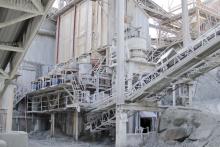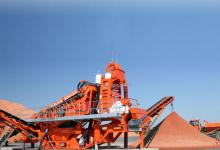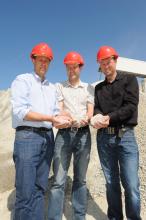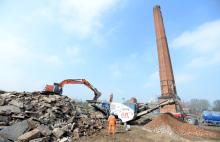
Reduced access to dwindling natural sand sites, coupled with higher quality sand products produced by crushing rock with premium crushing and screening equipment, has led to a flourishing manufactured sand sector within the quarrying and construction industries – a trend set to continue in the coming years. Below, building materials equipment solution experts from Metso analyse the pros and cons of manufactured sand, and how best to maximise its immense potential.
The demand for economical and efficient ways to produce crushed sand is growing, as natural sand deposits located near growth centres are being depleted and environmental regulations are getting stricter. What makes the change even more significant is the rapid pace of urbanisation. According to the United Nations, the number of people living in cities could double by 2050 to 6.5 billion. To accommodate growing populations, more houses, parks, roads, and subways, among other facilities, are needed – and all of these need sand in one form or another as a basic building component.
Many aggregates producers are now studying the possibility of producing crushed sand, and at the same time looking at how to address the growing piles of quarry waste, which may contain a fair proportion of fine aggregates that could be used in construction projects.
Is there a solution that would benefit all parties involved? Rolands Cepuritis, an expert on the use of crushed sand in concrete production, and Tero Onnela, sales support manager at
Sand – whether extracted from natural gravel or sand deposits or made by crushing bedrock – is used in many applications because of its mineral and physical qualities. The most typical application for sand is concrete, where it accounts for approximately 30–40% of the material volume.
Tero Onnela drills into the basics: “Concrete is the most common man-made material; you can find it everywhere. It is an essential element in the construction of infrastructure and in the building industry. Most of the interstate road network in the US is made of durable concrete, which can withstand heavy traffic and changing weather conditions. Dams – like the Three Gorges Dam in China, where Metso’s crushing equipment has been used to produce aggregates – are the biggest structures made of concrete.
“Asphalt, which is common in road and highway construction, is the second most important application. There are also the ‘functional’ aggregates, which are used, for example, for water purification in water treatment plants, golf courses and bunkers, children’s playgrounds, and horse-riding arenas, as well as on roads and sidewalks in icy climates to prevent sliding and slipping. In all of these applications, it is possible to replace natural sand with crushed sand, and even improve the properties of the end product.”
Natural sand is a diminishing natural resource
The use of natural sand is regulated by law in many places and totally forbidden in some places, like Japan. Some countries, including Sweden, have called for crushed sand to be used in place of natural sand whenever possible. In Australia, the constraints relating to obtaining approval are increasing, too.
Illegal sand mining has become an issue in some developing countries where demand is unbridled and the regulatory consequences are minimal. Selling sand is considered a quick way to make money with very little investment – all that is needed is a truck, a driver and a place from which to extract the sand. This is one of the reasons why India, among others, has established a sand policy to encourage the creation of new manufactured sand units by favouring them in the permit process for new quarries.
“I would say there are three categories of countries,” says Cepuritis. “Take Sweden, where you have a special natural gravel tax to regulate sand mining. Some other European countries restrict the opening of new pits by other means. Then there are countries, like India, Singapore, and Malaysia that have huge problems with non-existent or quickly diminishing natural sand resources. In these countries, sand is mined from open pits, beaches, and inland dunes, and dredged from ocean and river beds. Legislation is not always in place, or is just not effective.”
Crushed sand in concrete production
Cepuritis did his PhD thesis on the development of crushed sand for concrete production with micro-proportioning. He has a clear view of why crushed sand works well in concrete production:
“Concrete producers must meet certain minimum safety margins for the compressive strength of their products. The higher the variability of the raw materials, the higher the cement content needed to maintain a certain level of margins. Thus, at the end of the day, the cost of raw materials of a lower quality and lower variability is comparable to the cost of better quality materials, but of a variable quality.
“With crushed sand produced in a controlled, engineered process, it is possible to achieve stable quality. It is much more difficult to control the variability of natural sand, especially if the sand is not washed,” he says. Washing, however, is not always feasible due to problems like lack of space, availability of water resources, environmental issues relating to de-watering ponds, and operational problems in places that experience freezing temperatures, e.g. in the Nordic countries.
“There are also other direct technical benefits from the use of the crushed sand. For example, natural sand grains are rounded as a result of weathering, whereas crushed sand particles are typically angular and have a rougher surface texture, enabling better bonding with the cement paste in concrete, and thus providing improved strength properties at the same cement consumption (a constant water-to-cement ratio).”
When you are developing a concrete product with natural sand, opportunities for improvement are scarce. But with crushed sand, there are more opportunities: there is a wider range, and you can find the best fit for different types of concrete.
A totally different hurdle is the acceptance of the use of crushed sand in the mix design. Queensland, Australia, for example, still requires 40% of the fine aggregate used in a concrete mix design to be made up of natural sand. This will need to change in the future to reflect the declining resource availability and improved availability of high-quality crushed sand products.
A business case?
Legislation and availability of natural sand dictate the price of sand – and thus profitability. There are also costs associated with obtaining the approvals, which can result in it not being economically viable to extract the resource.
“Transportation costs from sand quarries contribute significantly to the overall cost of the product to the end user. If the end product is of higher value, like silica sand for glass manufacturing, higher transportation costs can be allowed. Higher-volume sand products with lower margins are a different case. The sand production site needs to be close to the location where it will be used,” Onnela explains.
“It’s a lot about economies of scale. If you have a good sandpit near the place of use, you just screen the sand to the right size. With crushed sand, you need to consider many other aspects. When crushing bedrock, production costs are higher and there are additional costs involved. Between 30% and 40% – and sometimes as much as 50% – of the crushed rock may end up in the quarry waste pile. The smaller the particle size and the softer the material quarried, the more waste is generated. To improve profitability, you either need to reduce the amount of waste, or figure out new uses for the fines,” Onnela clarifies.
“Particles less than 4mm are often considered waste, i.e. not good enough for any purpose. The material is often piled and, increasingly, producers have to pay waste fees for their piles. It would benefit all parties if the fines could be used and sold for other purposes. In Finland, this type of quarry waste can partly be used for surfacing driveways and yards.”
According to Onnela, making a business case is largely dependent on how the industry can develop and tailor the technical properties of crushed sand for different applications. It’s also a lot about educating and convincing stakeholders about the good qualities of crushed sand so that it becomes acceptable and widely adopted. Naturally, pricing needs to be competitive.
“It is possible to use most of the rock for concrete production. A certain level of rock hardness is needed. One of the biggest enemies is too much mica, which is difficult and expensive to remove. The question is: what does the market look like? Is there a lot of competition? In other words, is there a lot of sand available at a reasonable price?
“The quality of natural sand varies more than that of sand produced in an industrial process. Consistent quality is a typical feature of crushed sand. Concrete manufacturers benefit from the use of sand that is of a stable quality, because it allows them to use less cement, typically between 5% and 20% less cement. The decreased use of cement also benefits the environment through reduced CO2 emissions,” Onnela continues.
Cepuritis approaches the question with an illustrative case example:
“Let’s take a case from Norway. In this case, the transportation distance is short, less than 40 kilometres – for both manufactured and natural sand. The price for high-quality natural sand is NOK 80–85 per tonne, and the price for incomparable crushed sand as a by-product from coarse aggregate production is NOK 30–35. There is room to spend money on improving the quality.
“To add VSI crushing, you’d have to add NOK 10 to the production costs – and for fines classification, another NOK 10. This would allow for a product with a higher profit margin. However, it’s not so straightforward: you also have to be able to invest considerable resources in the development of the whole process. The producer needs to work together with the customer and understand their needs – and do technical sales on a totally new level that is not typical of the aggregate market in general. It’s both a challenge and an opportunity.”
Choosing the right technology
“Producing crushed sand is usually a much more complex process than simply extracting natural sand. Standalone crushed sand plants are rare, and production is usually integrated with the production of coarse crushed aggregate,” Cepuritis explains.
“The exact layout of a crushing plant can vary. The production process usually involves several size reduction stages, which include crushing, transport, size control and classification equipment.
“In terms of the equipment, all the necessary technology is already there. Metso has lots of knowledge in this area and can provide valuable insight for customers considering the manufacturing of crushed sand,” Onnela says.
“Further development is always underway. The biggest gap is in the material technology for concrete. Until now, all text books have been written with the default assumption of using natural sand. Practical concrete technologists don’t understand the new crushed material or how to optimise its use. A lot of research has been done during recent years, but it hasn’t been applied much.
“If you want to develop a crushed sand product at a quarry, you have to have a good understanding of the end material, i.e. concrete. You cannot just give a sample to your end customers – they will test it with current knowledge and, in many instances, fail. Instead, a much more direct technical sales approach is needed, educating customers in the possibilities of the new material and conducting lab trials together – pretty much in the same way that concrete admixtures, for example, are typically sold,” Cepuritis concludes.
How can Metso help meet the challenge?
Metso has years of know-how in different solutions for sand processing and a good portfolio of related equipment.
Shape is a major issue. This is where the role of crushing equipment is critical to ensure an acceptable shape and size. Cone crushers, like the Metso MX, Metso Nordberg HP Series and GP Series, enable the production of finer products together with coarser aggregates. They also lower the initial capital investment and save energy, due to having fewer crushing stages.
Metso’s HRC high-pressure grinding roll technology lends itself especially well to the production of sand. The inter-particle comminution method makes the cubical/angular product shape under the correct operating conditions.
“Studies show that the best end product for various purposes can be achieved with high-velocity impact crushing. The Metso Barmac VSI vertical shaft autogenous impactor improves the soundness and shape of the material and produces a quality that is very close to natural sand. Most other VSI crushers use metallic parts to crush rock, but the Barmac VSI, uses a rock-on-rock crushing method. The better the grain shape of the end product, the better its performance in concrete, asphalt and base mixtures. The rock-on-rock crushing and grinding action also provides the lowest cost-per-tonne of any impact crushing method,” Onnela clarifies.
Classifiers are then used to remove the needed amount of fine particles and dust. Metso static air classifiers, which are environmentally friendly and economical to use, produce consistent sand quality.
“For concrete, there are two important requirements. First, fresh concrete needs to be easy to work with; it needs to have good workability.
Secondly, it needs to reach the designed final hardened strength. Good, workable fresh concrete is easy to lay on a floor or cast in a form without too much physical effort. And the fresh concrete mass needs to stay uniform, without aggregate segregation or water bleeding. For asphalt and functional aggregates, there are grading specifications that must be met.”
Fulfilling these demands requires the crusher product to be screened/classified. Sand top size, normally 2–4mm, is screened with vibrating screens. Rock dust/filler can be classified best by wet processing or with air classifiers.
Air classification suits well for both concrete and asphalt production. In asphalt production, dry asphalt sand produced with air classification is an economical solution: it eliminates the need to evaporate water, which is an energy-intensive process in a hot mix asphalt plant.
Concrete sand can be tailored using two-stage air classification and mixing the classified filler back into the sand, if needed. In a basic case, one-stage air classification is adequate.
Given the need for lower cost, environmentally friendly building materials that can meet the huge challenge presented by the rapid pace of urbanisation highlighted at the start of this article, the case for using manufactured sand appears more and more compelling.









